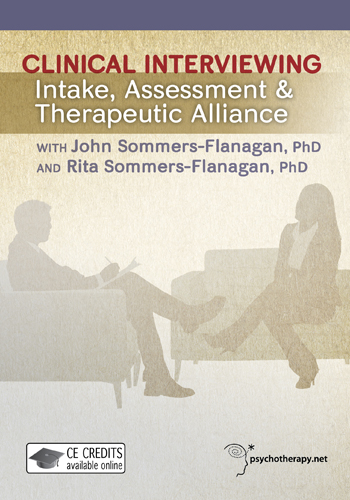 Overall, the Clinical Interviewing: Intake, Assessment, and Therapeutic Alliance video is a great product and I would recommend it to my students and colleagues. The video is associated with a textbook titled Clinical Interviewing (Wiley, 2014) and written by the video presenters, Professors John and Rita Sommers-Flanagan. The professors begin with basic interview skills and end with complex interviewing skills. The basic interview skills consist of the following: nondirective listening behaviors (i.e. Ivey’s attending behaviors) and responses, directive listening and action responses, and questions. Nondirective listening behaviors include the following: eye contact, body posture, voice tone and verbal tracking; and nondirective listening responses consist of the following: silence, clarification, paraphrasing, reflection of feeling and summarization. In contrast, directive listening and action responses include feeling validation, interpretive reflection of feeling, interpretation, reframe and confrontation. And the types of questions included are open, closed, indirect, swing, projective and therapeutic. The complex interviewing skills explained are intake assessment, mental status examination and suicide assessment. The professors provide lengthy demonstrations of how to complete a mental status examination and suicide assessment, which give the audience a good idea of how these assessments should be conducted.
Overall, the Clinical Interviewing: Intake, Assessment, and Therapeutic Alliance video is a great product and I would recommend it to my students and colleagues. The video is associated with a textbook titled Clinical Interviewing (Wiley, 2014) and written by the video presenters, Professors John and Rita Sommers-Flanagan. The professors begin with basic interview skills and end with complex interviewing skills. The basic interview skills consist of the following: nondirective listening behaviors (i.e. Ivey’s attending behaviors) and responses, directive listening and action responses, and questions. Nondirective listening behaviors include the following: eye contact, body posture, voice tone and verbal tracking; and nondirective listening responses consist of the following: silence, clarification, paraphrasing, reflection of feeling and summarization. In contrast, directive listening and action responses include feeling validation, interpretive reflection of feeling, interpretation, reframe and confrontation. And the types of questions included are open, closed, indirect, swing, projective and therapeutic. The complex interviewing skills explained are intake assessment, mental status examination and suicide assessment. The professors provide lengthy demonstrations of how to complete a mental status examination and suicide assessment, which give the audience a good idea of how these assessments should be conducted.
This video has a number of strengths. The material is presented developmentally, from basic interviewing skills to complex interviewing skills. The video features an option of viewing the entire presentation or selecting specific chapters that correspond with the clinical skills covered in the video. The chapters are well organized and all use the following format: (a) an introduction to the clinical skills to be covered in that chapter, (b) a brief lecture on those skills and how they are incorporated into sessions, (c) a clip of an actual session during which the counselor demonstrates the use of the skills, and (d) a debriefing of the session by the presenters, at which time they discuss the things that were done well and things that could have been done differently. In addition, at the beginning of each chapter the professors summarize the skills covered in previous chapter(s). The video also comes with a manual that provides an overview of the video and additional activities that can be completed along with it.
During the introduction to the video, Professors John and Rita Sommers-Flanagan stress the importance of being culturally aware of and sensitive to each individual client’s needs, and using one’s best clinical judgment when utilizing clinical interviewing skills. The importance of being culturally sensitive is stressed several times throughout the video. The professors also incorporate PowerPoint slides into the video, which are very helpful because the slides highlight key points that are discussed in each chapter prior to the demonstration of the clinical skills. In addition, during the demonstration sessions, whenever the counselor uses specific skills, the skills are identified at the bottom of the screen.
As previously stated, overall this video is a great resource; however, there are a couple of limitations worth noting. The material is presented from a limited client perspective in that the professors only focus on individual adult clients. During the brief lectures and discussions about different clinical skills, the professors do not mention how the skills might look different when used with couples, families, adolescents, older adults, etc. The presenters mainly focus on how a client’s culture influences the counseling process; they do not highlight the ways that different modalities and client characteristics might affect how clinical skills are implemented during a session. Furthermore, the feature of displaying which skills the counselors are using is both a strength and limitation; the limitation is the lack of an option to manipulate this function (turn it on/off). Providing the ability for an instructor to manipulate this function would offer him or her more options for classroom activities.
The video is structured for both instructional and independent use, so it can be used by counseling professionals. Counselor educators and other mental health educators can incorporate the video into their courses by showing the video in class or making it available for students to access outside class. Furthermore, professional counselors can use the video to independently to strengthen their clinical interviewing skills.
Reviewed by: Olivia Uwamahoro, NCC, doctoral candidate in counselor education, University of Central Florida, Orlando, Florida.
Irish Luck Productions (Producer), & Sommers-Flanagan, J., & Sommers-Flanagan, R. (Directors). (2014). Clinical interviewing: Intake, assessment, and therapeutic alliance with John Sommers-Flanagan, PhD and Rita Sommers-Flanagan, PhD [DVD]. (Available in DVD and video streaming from http://www.psychotherapy.net/video/clinical-interview-intake-assessment-training)
Available in DVD and streaming format as part of video subscription at Psychotherapy.net/subscriptions.
The Professional Counselor
https://tpcwordpress.azurewebsites.net
